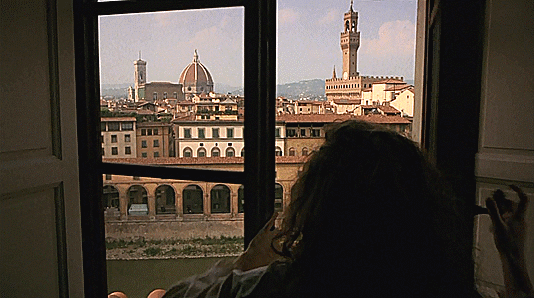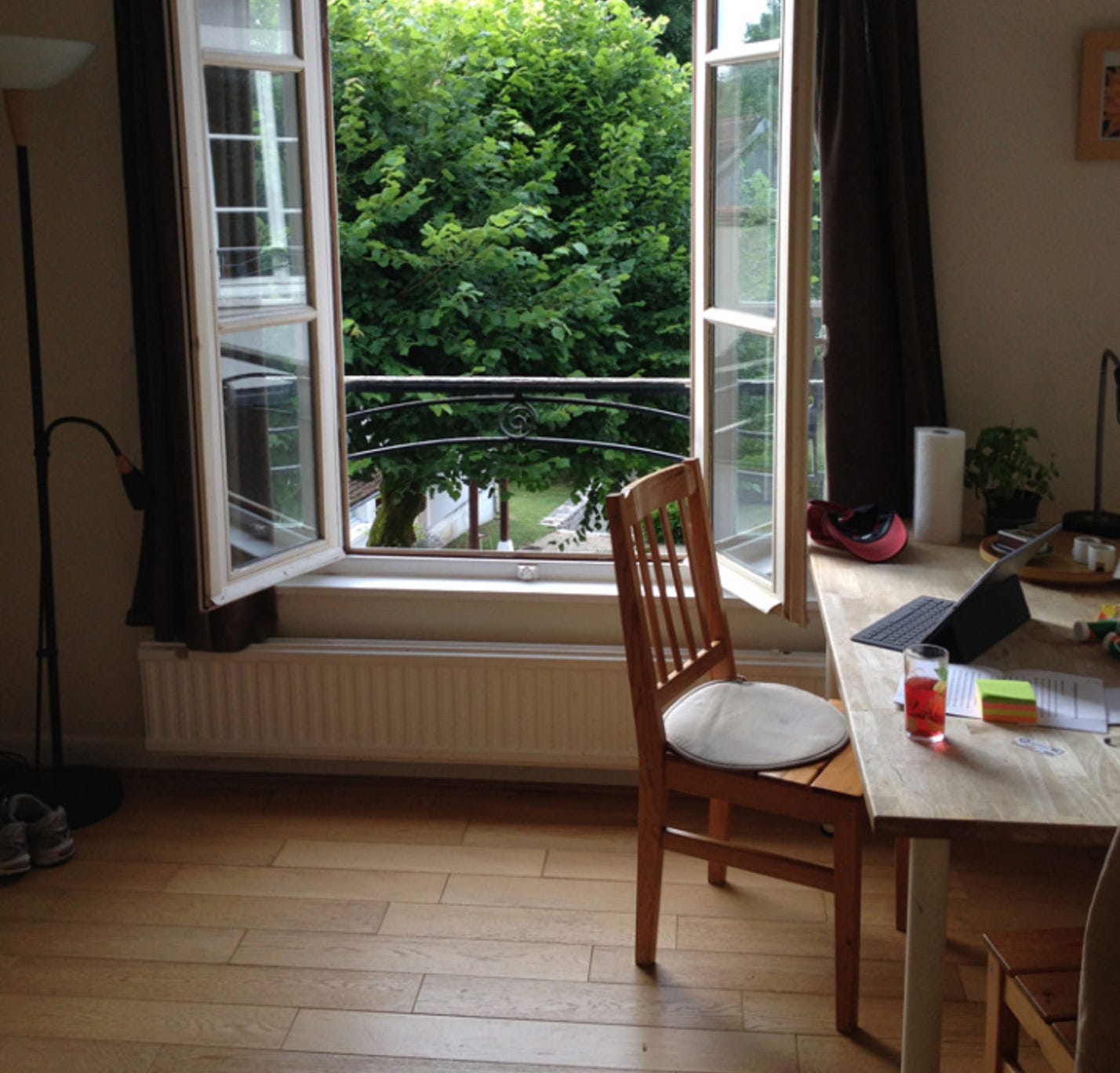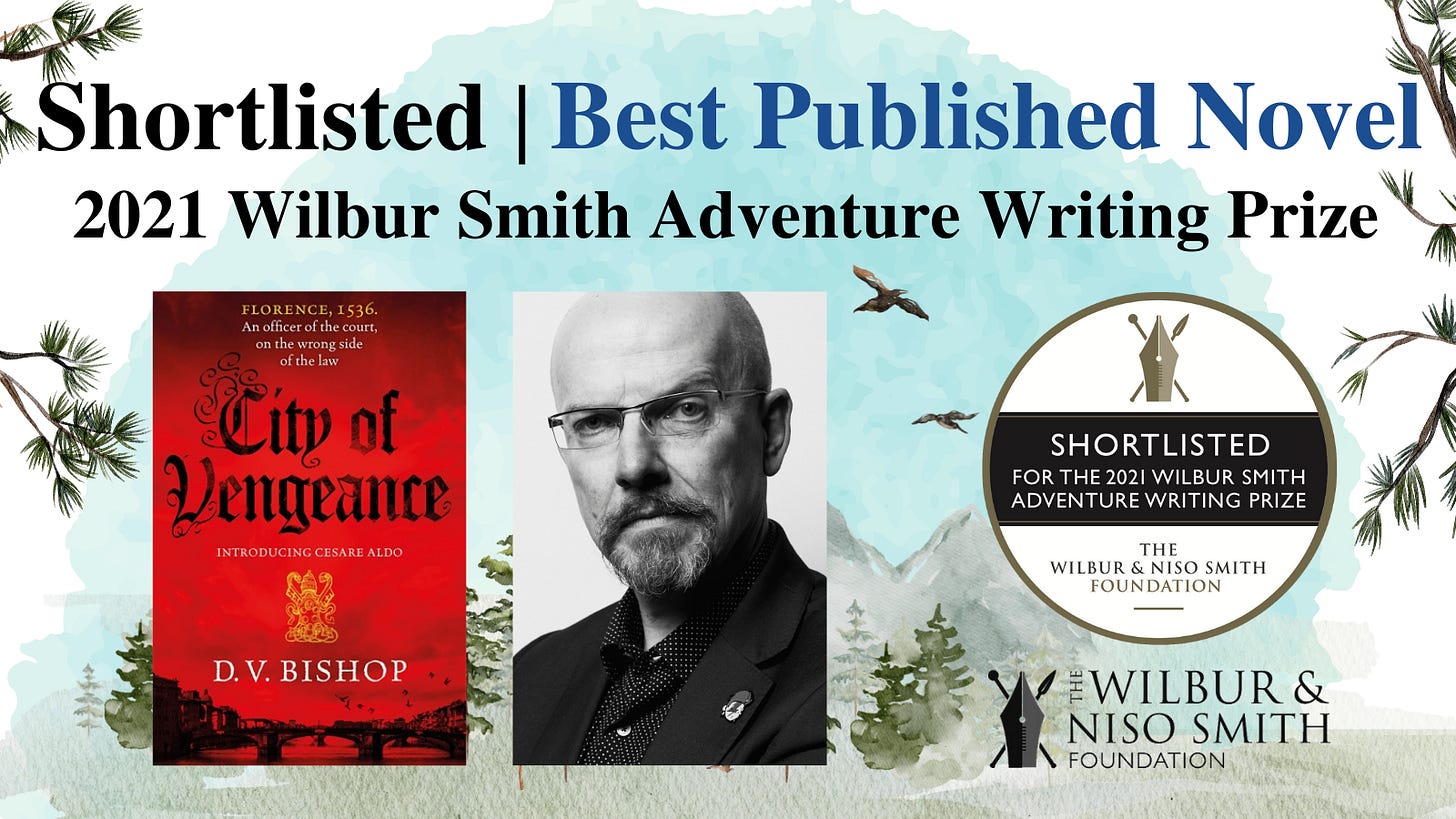Writing Vengeance
Behind the scenes on Cesare Aldo #1
Welcome to the free newsletter of David (D. V.) Bishop, author of the Cesare Aldo historical thrillers set in Renaissance Italy. This time: the first in a series looking back at the creation of these novels, starting with City of Vengeance.
Inspiration
I suspect it was seeing the 1985 Merchant Ivory adaptation of E. M. Forster’s novel A Room with a View that gave me a fascination with Florence. The city looks intriguing and romantic in the film, full of history and danger. I vowed to see Florence one day, despite living on the other side of the world.
Fast forward to the late 1990s when I was resident in London. Browsing in a bookshop near the British Museum, I spied a slim volume about crime in late Renaissance Florence. It fell open to a page that stated the criminal justice system back then was roughly comparable to a modern police force.
That was the lightning bolt moment of inspiration! I was immediately imagining a kind of police procedural novel set in Renaissance Florence, combining my love of crime fiction and an enduring need to see that city. I still hadn’t been there, but I was now at least a lot closer to Florence geographically.
There were several other barriers to starting the novel: I couldn’t speak any Italian, and I knew next to nothing about the histories of Italy, Florence or the Renaissance. If I was going to make a decent job of this idea, I would need to do a lot of research first. I didn’t realise that would be a 20-year journey.
I made an initial, fleeting visit to Florence in May 2001 – just a day trip, but enough to make me want to return. I went back several times for information and inspiration, falling in love with the city again, this time in person. Yet I hesitated to write, fearful I would fail to fulfil the promise of my premise.
Perspiration
In 2016 I recognised a simple fact: to write a novel worthy of my initial inspiration, I would first have to write a draft and then make it better. But many years as a journalist and then as editor of a weekly title, I struggle to start without a deadline. Alas, I need that imperative to overcome my natural inertia.
My solution was commencing a part-time Creative Writing PhD at Lancaster University via distance learning in January 2017. That gave me much-needed deadlines, plus a supervisor’s feedback. Even then, I spent the first six months planning, plotting and preparing to start a draft – but not actually starting.
ABOVE: The room where I wrote the opening chapters for City of Vengeance
I had applied for a Robert Louis Stevenson Fellowship, thinking nothing would come of it. To my immense surprise, I was selected to spend a month writing at Grez-sur-Loing, a wee village an hour south of Paris. That’s where I finally began my long-delayed novel, drafting the first fifty pages.
I kept going when I returned from France, stealing time around my university teaching job to write. In 2018 I entered the Pitch Perfect contest at the Bloody Scotland international crime writing festival in Stirling. Winning that gave me a boost to press on, and I finished my first draft in November 2018.
A cut and polish followed before it went to a manuscript consultant for their notes, leading to a third draft. The novel – then called Safer to be Feared - went out to agents in spring 2019, and I signed with Jenny Brown soon after. Pan Macmillan acquired the manuscript in a two-book deal for publication in February 2021.
Synopsis: City of Vengeance
Florence. Winter, 1536. A prominent Jewish moneylender is murdered in his home, a death with wide implications in a city powered by immense wealth.
Cesare Aldo, a former soldier and now an officer of the Renaissance city’s most feared criminal court, is given four days to solve the murder: catch the killed before the feast of Epiphany – or suffer the consequences.
During his investigations Aldo uncovers a plot to overthrow the volatile ruler of Florence, Alessandro de’ Medici. If the Duke falls, it will endanger the whole city. But a rival offer of the court is determined to expose details about Aldo’s private life that could lead to his ruin. Can Aldo stop the conspiracy before anyone else dies, or will his own secrets destroy him first?
Reception
The first Cesare Aldo historical thriller City of Vengeance (Pan Macmillan chose the new name) was published in February 2021 during the lengthy second Covid-19 lockdown while bookshops were all shut. But it found readers eager to escape the pandemic via a trip in time to Renaissance Florence.
In May 2021 it was announced City of Vengeance had been longlisted for the Wilbur Smith Adventure Writing Prize. The novel made the six-strong shortlist as well, getting a healthy promo burst despite most events being stuck online. (Miss Benson’s Beetle by Rachel Joyce won the £10,000 prize.)
City of Vengeance went on to win the NZ Booklovers Award early 2022, and was longlisted for the Crime Writers’ Association Gold Dagger, the CWA Historical Dagger, and the Ngaio Marsh Award for Best Novel. Just as unexpected were the kind words from far more established authors about the book.
Global bestselling author David Baldacci called it ‘A first-class historical thriller with echoes of The Name of the Rose . . . a tour-de-force and clearly demonstrates the sixteenth century was as full of thrills and mysteries as the twenty-first, perhaps even a shade more.’
It got a pick of the month in The Times (‘Cross-dressing, torture, oodles of violence ― this pungent example of historical noir has the lot’) and by the Evening Standard: ‘Brings to life the 16th century Italian city of art and literature that is also riddled with corruption, anti-Semitism and violence.’
Reflection
I’ve been re-examining City of Vengeance of late as part of the critical element for my PhD (no, still haven’t finished that, despite the book being on sale for nearly five years - sigh). Happily, the novel holds up pretty well despite some historical howlers (pews in churches, tomatoes in Tuscan cooking).
ABOVE: My local indie Atkinson-Pryce Books had this wonderful window display to advertise the online launch for City of Vengeance in the midst of a pandemic lockdown
It establishes Aldo as a man willing to do whatever is necessary in his pursuit of justice. The book introduces a rich ensemble of characters that I’ve continued to explore and develop in the novels which followed, and makes good use of sensory immersion to transport readers to Renaissance Florence.
To my eye the narrative gains a real sense of scale and significance by incorporating real, tumultuous events from history as part of the plot. Aldo certainly suffers physically and emotionally in this novel, more so than in later books - I definitely didn’t hold back on that aspect of the storytelling.
Some aspects of the manuscript surprised me while I was drafting it, especially Aldo and Saul’s relationship. I had no plans for this to be part of the novel yet it blossomed on the page. I embraced that and am glad I did; their interactions often add a warm humanity amid all the death and detection.
In summary, I’m proud of City of Vengeance and the readership it has helped me find. The book is far from flawless, but this is true of most novels. Best of all, it created the foundations on which I’ve been able to build my series of historical thrillers. Aldo hit the ground running here – long may that continue.
You can hear me talk more about creating City of Vengeance here on The Aldocast:
If you’ve been forwarded this newsletter by a friend, feel free to subscribe. But if you no longer wish to receive it, click unsubscribe at the bottom of the page.






You hadn't visited Florence before 2021?! Wow 🤯 (Or is that a typo?)